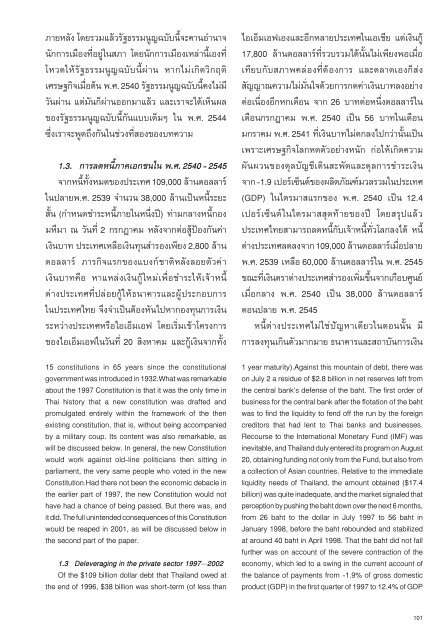บ้านเรือนถิ่นไทยในช่วงเจ็ดทศวรรษ 2489-2559
You also want an ePaper? Increase the reach of your titles
YUMPU automatically turns print PDFs into web optimized ePapers that Google loves.
ภายหลัง โดยรวมแล้วรัฐธรรมนูญฉบับนี้จะคานอำนาจ<br />
นักการเมืองที่อยู่ในสภา โดยนักการเมืองเหล่านี้เองที่<br />
โหวตให้รัฐธรรมนูญฉบับนี้ผ่าน หากไม่เกิดวิกฤติ<br />
เศรษฐกิจเมื่อต้น พ.ศ. 2540 รัฐธรรมนูญฉบับนี้คงไม่มี<br />
วันผ่าน แต่มันก็ผ่านออกมาแล้ว และเราจะได้เห็นผล<br />
ของรัฐธรรมนูญฉบับนี้กันแบบเต็มๆ ใน พ.ศ. 2544<br />
ซึ่งเราจะพูดถึงกันในช่วงที่สองของบทความ<br />
1.3. การลดหนี้ภาคเอกชนใน พ.ศ. 2540 - 2545<br />
จากหนี้ทั้งหมดของประเทศ 109,000 ล้านดอลลาร์<br />
ในปลายพ.ศ. 2539 จำนวน 38,000 ล้านเป็นหนี้ระยะ<br />
สั้น (กำหนดชำระหนี้ภายในหนึ่งปี) ท่ามกลางหนี้กอง<br />
มหึมา ณ วันที่ 2 กรกฎาคม หลังจากต่อสู้ป้องกันค่า<br />
เงินบาท ประเทศเหลือเงินทุนสำรองเพียง 2,800 ล้าน<br />
ดอลลาร์ ภารกิจแรกของแบงก์ชาติหลังลอยตัวค่า<br />
เงินบาทคือ หาแหล่งเงินกู้ใหม่เพื่อชำระให้เจ้าหนี้<br />
ต่างประเทศที่ปล่อยกู้ให้ธนาคารและผู้ประกอบการ<br />
ในประเทศไทย จึงจำเป็นต้องหันไปหากองทุนการเงิน<br />
ระหว่างประเทศหรือไอเอ็มเอฟ โดยเริ่มเข้าโครงการ<br />
ของไอเอ็มเอฟในวันที่ 20 สิงหาคม และกู้เงินจากทั้ง<br />
15 constitutions in 65 years since the constitutional<br />
government was introduced in 1932.What was remarkable<br />
about the 1997 Constitution is that it was the only time in<br />
Thai history that a new constitution was drafted and<br />
promulgated entirely within the framework of the then<br />
existing constitution, that is, without being accompanied<br />
by a military coup. Its content was also remarkable, as<br />
will be discussed below. In general, the new Constitution<br />
would work against old-line politicians then sitting in<br />
parliament, the very same people who voted in the new<br />
Constitution.Had there not been the economic debacle in<br />
the earlier part of 1997, the new Constitution would not<br />
have had a chance of being passed. But there was, and<br />
it did. The full unintended consequences of this Constitution<br />
would be reaped in 2001, as will be discussed below in<br />
the second part of the paper.<br />
1.3 Deleveraging in the private sector 1997–2002<br />
Of the $109 billion dollar debt that Thailand owed at<br />
the end of 1996, $38 billion was short-term (of less than<br />
ไอเอ็มเอฟเองและอีกหลายประเทศในเอเชีย แต่เงินกู้<br />
17,800 ล้านดอลลาร์ที่รวบรวมได้นั้นไม่เพียงพอเมื่อ<br />
เทียบกับสภาพคล่องที่ต้องการ และตลาดเองก็ส่ง<br />
สัญญาณความไม่มั ่นใจด้วยการกดค่าเงินบาทลงอย่าง<br />
ต่อเนื่องอีกหกเดือน จาก 26 บาทต่อหนึ่งดอลลาร์ใน<br />
เดือนกรกฎาคม พ.ศ. 2540 เป็น 56 บาทในเดือน<br />
มกราคม พ.ศ. 2541 ที่เงินบาทไม่ตกลงไปกว่านั้นเป็น<br />
เพราะเศรษฐกิจโลกหดตัวอย่างหนัก ก่อให้เกิดความ<br />
ผันผวนของดุลบัญชีเดินสะพัดและดุลการชำระเงิน<br />
จาก -1.9 เปอร์เซ็นต์ของผลิตภัณฑ์มวลรวมในประเทศ<br />
(GDP) ในไตรมาสแรกของ พ.ศ. 2540 เป็น 12.4<br />
เปอร์เซ็นต์ในไตรมาสสุดท้ายของปี โดยสรุปแล้ว<br />
ประเทศไทยสามารถลดหนี้กับเจ้าหนี้ทั่วโลกลงได้ หนี้<br />
ต่างประเทศลดลงจาก 109,000 ล้านดอลลาร์เมื่อปลาย<br />
พ.ศ. 2539 เหลือ 60,000 ล้านดอลลาร์ใน พ.ศ. 2545<br />
ขณะที่เงินตราต่างประเทศสำรองเพิ่มขึ้นจากเกือบศูนย์<br />
เมื่อกลาง พ.ศ. 2540 เป็น 38,000 ล้านดอลลาร์<br />
ตอนปลาย พ.ศ. 2545<br />
หนี้ต่างประเทศไม่ใช่ปัญหาเดียวในตอนนั้น มี<br />
การลงทุนเกินตัวมากมาย ธนาคารและสถาบันการเงิน<br />
1 year maturity).Against this mountain of debt, there was<br />
on July 2 a residue of $2.8 billion in net reserves left from<br />
the central bank’s defense of the baht. The first order of<br />
business for the central bank after the flotation of the baht<br />
was to find the liquidity to fend off the run by the foreign<br />
creditors that had lent to Thai banks and businesses.<br />
Recourse to the International Monetary Fund (IMF) was<br />
inevitable, and Thailand duly entered its program on August<br />
20, obtaining funding not only from the Fund, but also from<br />
a collection of Asian countries. Relative to the immediate<br />
liquidity needs of Thailand, the amount obtained ($17.4<br />
billion) was quite inadequate, and the market signaled that<br />
perception by pushing the baht down over the next 6 months,<br />
from 26 baht to the dollar in July 1997 to 56 baht in<br />
January 1998, before the baht rebounded and stabilized<br />
at around 40 baht in April 1998. That the baht did not fall<br />
further was on account of the severe contraction of the<br />
economy, which led to a swing in the current account of<br />
the balance of payments from -1.9% of gross domestic<br />
product (GDP) in the first quarter of 1997 to 12.4% of GDP<br />
101


















